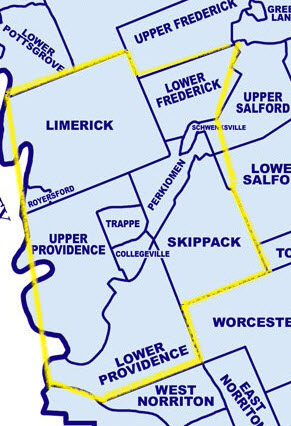A VALLEY RICH IN HISTORY…
When European settlers first came to what would be called Pennsylvania, they found about 15,000 Native Americans, most from the Delaware or Lenni-Lenape tribe, living primarily in the southeast section.
What is now the Commonwealth of Pennsylvania (“Penn’s Woods”) was created on March 4, 1681 by King Charles II of England. He granted William Penn, a prominent Quaker, most of what we know as Pennsylvania to repay a debt owed Penn’s father, Admiral William Penn.
Pennsylvania later became known as the Quaker State and the Keystone State, the latter name suggesting its position in the arch of the 13 original colonies.
The Perkiomen Valley was important from Pennsylvania’s earliest days because its rich farmlands provided food for residents of Philadelphia. During the Revolutionary War, Washington’s troops wintered in nearby Valley Forge.
Montgomery County was formed in 1784 from land taken from Philadelphia. Limerick Township is one of the first townships formed in Montgomery County. Limerick’s original settlers came from Germany and Holland in the early 18th century. The township’s borders took their current form in 1879 with the separation of Royersford Borough. Today, Limerick Township is the fastest growing area within the Perkiomen Valley. There are many new residential developments because of the new 422 Expressway that runs through Limerick from King of Prussia to Pottstown. It is also home to PECO Energy Company’s Limerick Nuclear Generating Station, the Pottstown-Limerick Airport, and several golf courses.
“Skippack and Perkioming Township,” as it was known then, was formed in 1725. In 1886 it divided into Skippack Township and Perkiomen Township, separated by the Perkiomen Creek. Perkiomen Township includes Rahns and Graterford, although most properties have Collegeville mailing addresses. Skippack Township includes Creamery and Skippack Village, which contains many small antique and craft shops.
The first copper mine in Pennsylvania was operating near Schwenksville before 1720. For a time after the railroad reached Schwenksville in 1869, this area was a summer resort on the Perkiomen Creek. Schwenksville Borough was incorporated in 1903, with its original land coming from Perkiomen Township. Schwenksville reached its current form in 1972 with the addition of land from Lower Frederick Township.
Lower Providence Township and Upper Providence Township were created in 1805 by splitting Providence Township in two. Both townships were largely agricultural until recently. Lower Providence Township includes Audubon, Eagleville, Evansburg, Trooper and the Valley Forge Industrial Park and Corporate Center.
John James Audubon (1785-1851) had his first home in America at Mill Grove in Lower Providence Township. The French-American ornithologist was noted for his bird drawings and paintings, published in Birds of America.
The largest developments in Upper Providence Township are at the intersection of the 422 Expressway and Route 29: GlaxoSmithKline, and the headquarters of Wyeth Pharmaceuticals. Upper Providence includes Mont Clare and Oaks.
Collegeville (formerly called “Perkiomen Bridge” and “Freeland”) and Trappe were incorporated in 1896 from land that had been part of Upper Providence Township. Freeland Seminary was founded in 1848 by Abraham Hunsicker in what is now Collegeville. Ursinus College purchased it in 1869. Pennsylvania Female College was founded in 1851 and closed in 1880, at which time Ursinus began to admit women.
Until the Pennsylvania Turnpike and the more recently opened 422 Expressway, Collegeville and Trappe had a strategic position at the midpoint of the Philadelphia-Reading Pike. The Perkiomen Bridge Hotel, built in Collegeville in the 1700s, is one surviving example of the taverns and inns built to service this travel trade.
Henry Melchior Muhlenberg, whose restored home is on Main Street in Trappe, founded the Lutheran Church in America. His eldest son, John Peter Gabriel Muhlenberg, became a major general in the Continental Army, was a vice-president of Pennsylvania and a U.S. representative. Another son, Frederick Augustus Conrad Muhlenberg, served various Lutheran congregations until he was elected to the Continental Congress in 1779. A member of the U.S. House of Representatives, he was its first Speaker. A grandson, Henry Augustus Philip Muhlenberg, was the first U.S. minister to Austria.
Lower Frederick Township and Upper Frederick Township were formed in 1919 with the division of Frederick Township. Their original settlers were of Pennsylvania Dutch descent. Mostly still rural and agricultural, this area has experienced residential development. Lower Frederick Township includes Spring Mount and Zieglerville. Upper Frederick Township includes Frederick, Obelisk, Perkiomenville, and Montgomery County’s 536 acre Upper Perkiomen Valley Park.
…WITH EVEN MORE TO OFFER TODAY
Early on, middle-class Philadelphians would try to escape the summer heat by riding the train out of the city to retreat to their summer homes along the Perkiomen Creek in Collegeville, Schwenksville, Skippack and Trappe. When the transportation infrastructure–particularly highways–was developed, people began to live here year-round and commute to their jobs in the city.
So the Perkiomen Valley came to be known as a bedroom community, one that retained its rich heritage and pleasant rural lifestyle. In more recent decades, companies began moving to this area, too, to escape the growing problems of the inner city, to attract skilled labor, and to be more conveniently located for their employees and customers.
Most recently this trend has accelerated as technological developments in telecommunications and computers have enabled all businesses, not just those located in major cities, to look at and service markets with a more national and international perspective.
Today, the valley continues to grow and prosper while preserving its history, culture and unique, small-town sensibility.
Growth is a key word in this area. In the most recent census (2010), the Perkiomen Valley had a population of 102,416. This represents tremendous growth in the region since 2000.

